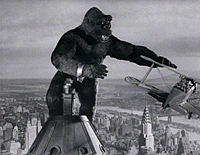The Passion of the Kong
How to Turn a Classic into a Masterpiece
An Appreciation by Barry M. Lamont
1933 The Arrival of The Jazz Singer
The arrival of The Jazz Singer in 1927 - the first all-talking picture, with the sound track attached to the film - heralded a new era in the impact and the immediacy of the moviegoing experience. The success of The Jazz Singer led most studios to redesign their operations to produce sound films - an era hilariously documented in Singing in the Rain, the greatest American movie musical, ever - and in 1929, large numbers of sound films began appearing for the first time. Just four years later, Merian C. Cooper and Ernest B. Schoedsack released one of the landmarks of cinema: King Kong.
King Kong expanded the boundaries of cinema, re-defined the ability of movies to show the audience things they had never experienced before, perhaps never even imagined. It was not the first stop-motion animation epic; in fact, the same man who created King Kong, Willis O'Brien, had done the visual effects for The Lost World in 1925, an adaptation of Arthur Conan Doyle's story about dinosaurs inhabiting a plateau deep in the jungles of South America. (The Lost World may even have been a better overall film than King Kong, but as a "mere" silent film, it was not preserved, and survives only in a truncated version.)
Although King Kong is rightly considered a classic, it is not remembered for its witty, incisive dialogue, or its subtle, compelling acting. It is one of the first big-budget special effects pictures, the ancestor of Star Wars. Topical references and social attitudes may be the elements of a film which make it feel out of date most quickly, but special effects are next on the list; so the idea of remaking a special effects film with significantly better visual effects is an entirely reasonable goal. Remake Casablanca without Bogart and Bergman, or Rebel Without a Cause without James Dean, or Citizen Kane without Orson Welles? Don't waste my time. But remake King Kong with phenomenal visual effects? Absolutely.
King Kong expanded the boundaries of cinema, re-defined the ability of movies to show the audience things they had never experienced before, perhaps never even imagined. It was not the first stop-motion animation epic; in fact, the same man who created King Kong, Willis O'Brien, had done the visual effects for The Lost World in 1925, an adaptation of Arthur Conan Doyle's story about dinosaurs inhabiting a plateau deep in the jungles of South America. (The Lost World may even have been a better overall film than King Kong, but as a "mere" silent film, it was not preserved, and survives only in a truncated version.)
Although King Kong is rightly considered a classic, it is not remembered for its witty, incisive dialogue, or its subtle, compelling acting. It is one of the first big-budget special effects pictures, the ancestor of Star Wars. Topical references and social attitudes may be the elements of a film which make it feel out of date most quickly, but special effects are next on the list; so the idea of remaking a special effects film with significantly better visual effects is an entirely reasonable goal. Remake Casablanca without Bogart and Bergman, or Rebel Without a Cause without James Dean, or Citizen Kane without Orson Welles? Don't waste my time. But remake King Kong with phenomenal visual effects? Absolutely.
